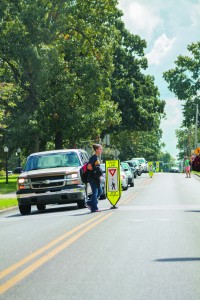
Jessica Reedy, freshman from Paducah, Ky., crosses one of the many crosswalks with traffic awareness signs on 16th street.
Earlier this year, the University and the city completed a study on 16th Street and the safety of its pedestrians and drivers.
Students were entering the crosswalks without checking for traffic and drivers were involved in vehicular accidents due to frequent, sudden stops.
The City of Murray Public Safety Committee, which commissioned the city to compile data relating to the use of the road, brought the issue of increasing safety precautions along 16th Street to the city’s attention two months ago.
Ron Albritten, street superintendent of Murray, said the city did a traffic engineering study earlier in the year to see what could be done to lower the accident toll and near misses on 16th Street.
“We wanted to increase awareness of traffic and pedestrians and make them more aware of each other,” Albritten said. “The first and cheapest things the engineers recommended was the installation of the street signs in the crosswalks. They have a pedestrian and traffic-calming affect.”
The awareness signs cost the city about $3,500. The signs were the cheapest option recommended by the street engineers. These signs are also not specific to Murray; speed awareness signs are being used across the nation to attract attention to drivers and pedestrians.
Albritten said 97 percent of people who are crossing 16th Street use the crosswalk. While he said this is a good sign of people using them correctly, Albritten said 47 percent of people using the crosswalk never look before entering the street.
“We’ve got to get their attention, too,” Albritten said.
He said the city has to wait six months to see how effective the street signs are, and if the signs are making a difference in the number of incidents.
“Hopefully we can get both parties, the drivers and the pedestrians, to be aware of the other,” Albritten said. “Most pedestrians think they have the right-of-way, when really if the traffic is too close they are producing a hazardous condition and lose that right.”
He said often pedestrians do not look before they enter a street, because they think just because a crosswalk is there, it makes it safer.
“We experience one vehicle-pedestrian accident per year on average,” Albritten said. “Along with that, we have five or more vehicle accidents. 16th Street has one of the highest accident potentials in the city.”
He said the rate of pedestrians crossing the street at 16th Street is one of the factors in the high number of accidents.
“The drivers are seeing the pedestrians at the last minute or the pedestrians are not looking before walking into traffic and this is causing panic stops,” Albritten said.
Matt Mattingly, city administrator, said an average of 7,200 vehicles travel along 16th Street per day and he said it is the third most used road by cars in Murray and the most used road by pedestrians.
“We’re trying to heighten awareness and education,” Albritten said.
Interim President Tim Miller said he received several emails from faculty members reporting the danger of the situation and their concern about students and drivers.
“Students are crossing wherever they can,” Miller said. “The students need to be careful because of the drivers and the drivers need to be careful because of the students.”
Along with findings from the 16th Street data, the Department of Highway Safety is also looking into the scarcity of crosswalks on 15th Street.
Over the summer, road crews repaved the road, leaving no crosswalks for pedestrians.
Since 15th Street is a city-owned street, the University has no control over the lack of crosswalks, but a study was completed to see what the best option was for reinstalling crosswalks.
At the beginning of the semester, hoses were laid across the street counting cars, their speed, direction of travel and other data to be used for the traffic engineering study to determine if, and how many, crosswalks would be placed on 15th Street.
“I know there are going to have be some safety improvements to the sidewalk,” Albritten said. “One of the biggest problems over there is there no safe harbor for the pedestrians at the end of the crosswalk.”
He said the crosswalks that were placed on 15th Street had some problems with placement. He thinks more crosswalks will be implemented on 15th Street, but does not have an exact date on when pedestrians can expect to see them.
Story by Meghann Anderson, News Editor
How about teaching students to USE the crosswalks? I travel this part of 16th daily to get to my home and I see students crossing the street just feet from the crosswalks!